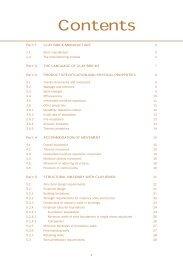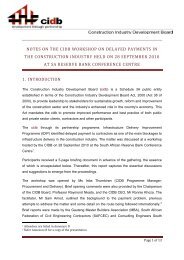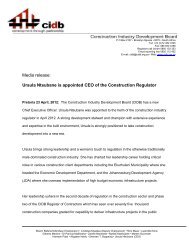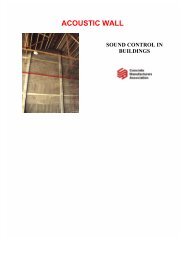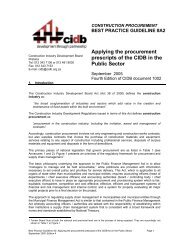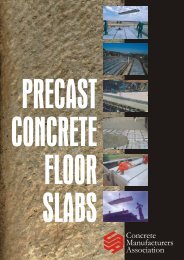MANUAL 4 - Construction Industry Development Board
MANUAL 4 - Construction Industry Development Board
MANUAL 4 - Construction Industry Development Board
Create successful ePaper yourself
Turn your PDF publications into a flip-book with our unique Google optimized e-Paper software.
MODULE<br />
1<br />
2<br />
3<br />
4<br />
5<br />
6<br />
7<br />
<strong>MANUAL</strong> 4 – BITUMINOUS PAVEMENT SEALS<br />
Once the rate of application has been calculated, then the total quantities of aggregate<br />
required for a project can be found.<br />
Length of road (m) 3 breadth of road (m) = Area m 2<br />
Area (m²) 3 Rate of application in m3/m 2 = Area (m 2 ) 3 Rate (m3/ m 2 )<br />
= Volume in m3<br />
Having calculated the volume of aggregate required for the ALD, a percentage must be<br />
added for wastage – 5% under ideal conditions and 10% for severe conditions.<br />
If the stone is placed on a clean surface and all the aggregate can be picked up, the 5% will<br />
cover the wastage, but if the stone is placed on a rough shoulder then it will not be possible<br />
to use all the stone from the stockpile, so 10% must be allowed.<br />
Volume calculated = 100% to allow 5% then<br />
Volume adjusted = 105%<br />
Volume calculated 3 1,05 = Adjusted volume to be ordered<br />
Spotting of aggregate<br />
To obtain a uniform application of aggregate by hand labour, it is necessary to place the<br />
heaps of aggregate in predetermined quantities and at uniform intervals, along the side of<br />
the road to be surfaced. This is known as spotting the aggregate quantities. See Photos 4.13<br />
and 4.14.<br />
Photos 4.13 and 4.14: Spotting of aggregate<br />
The aggregate can be placed in heaps along the side of the road that is to be surfaced. A half<br />
210 litre drum with the bottom of the drum removed and two handles attached to the drum<br />
for ease of handling, can be used for this operation.<br />
The spacing of the aggregate heaps can be calculated as follows:<br />
210/2 (half drum) = 105 litres of aggregate<br />
= 0,105 m 3 (1 000 litres = 1 m 3 )<br />
The application rate (R) = m 3 /m 2<br />
(Assuming that the rate of application is 0.0083 m 3 /m 2 determined from the pan and cylinder<br />
test.)<br />
IMPLEMENTING EMPLOYMENT INTENSIVE ROAD WORKS 34





